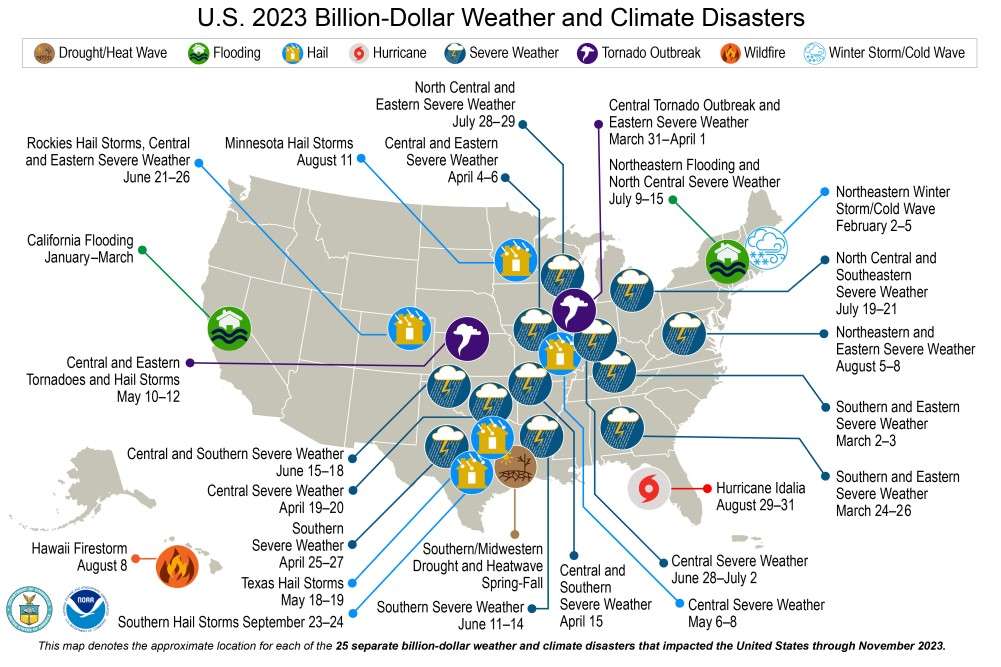Billion-dollar weather and climate disasters: Overview
The U.S. has sustained 373 weather and climate disasters since 1980 where overall damages/costs reached or exceeded $1 billion (including CPI adjustment to 2023). The total cost of these 373 events exceeds $2.655 trillion.
2023 in progress…
In 2023 (as of December 8), there have been 25 confirmed weather/climate disaster events with losses exceeding $1 billion each to affect United States. These events included 1 drought event, 2 flooding events, 19 severe storm events, 1 tropical cyclone event, 1 wildfire event, and 1 winter storm event. Overall, these events resulted in the deaths of 482 people and had significant economic effects on the areas impacted. The 1980–2022 annual average is 8.1 events (CPI-adjusted); the annual average for the most recent 5 years (2018–2022) is 18.0 events (CPI-adjusted).

Potential billion-dollar event
Note: The following is a compilation of events in which damage costs potentially exceed the $1 billion-dollar threshold. This is only a preliminary list as calculations are not yet finalized and total costs have not been determined (as of December 8, 2023).
- Tropical Storm Hilary (August 2023): Tropical Storm Hilary caused a first-ever tropical storm watch to be issued for southern California, as it brought record-breaking rainfall and flooding across parts of the Southwest.
Methodology and data sources
The National Centers for Environmental Information (NCEI) is the Nation's Scorekeeper in terms of addressing severe weather and climate events in their historical perspective. As part of its responsibility of monitoring and assessing the climate, NCEI tracks and evaluates climate events in the U.S. and globally that have great economic and societal impacts. NCEI is frequently called upon to provide summaries of global and U.S. temperature and precipitation trends, extremes, and comparisons in their historical perspective. Found here are the weather and climate events that have had the greatest economic impact from 1980 to 2023.
In 2012, NCEI -- then known as National Climatic Data Center (NCDC) -- reviewed its methodology on how it develops Billion-dollar Disasters. NCEI held a workshop with economic experts (May, 2012) and worked with a consulting partner to examine possible inaccuracy and biases in the data sources and methodology used in developing the loss assessments (mid-2013). This ensures more consistency with the numbers NCEI provides on a yearly basis and give more confidence in the year-to-year comparison of information. Another outcome is a published peer-reviewed article "U.S. Billion-dollar Weather and Climate Disasters: Data Sources, Trends, Accuracy and Biases" (Smith and Katz, 2013). This research found the net effect of all biases appears to be an underestimation of average loss. In particular, it is shown that the factor approach can result in an underestimation of average loss of approximately 10–15%. This bias was corrected during a reanalysis of the loss data to reflect new loss totals.
It is also known that the uncertainty of loss estimates differ by disaster event type reflecting the quality and completeness of the data sources used in our loss estimation. In 2019, six of the fourteen billion-dollar events (i.e., three inland floods events, California/Alaskan wildfires, tropical cyclones Dorian and Imelda) have higher potential uncertainty values around the loss estimates due to less coverage of insured assets and data latency. The remaining eight events (i.e., the severe storm events producing tornado, hail and high wind damage) have lower potential uncertainty surrounding their estimate due to more complete insurance coverage and data availability. Our newest research defines the cost uncertainty using confidence intervals as discussed in the peer-reviewed article "Quantifying Uncertainty and Variable Sensitivity within the U.S. Billion-dollar Weather and Climate Disaster Cost Estimates" (Smith and Matthews, 2015). This research is a next step to enhance the value and usability of estimated disaster costs given data limitations and inherent complexities.
In performing these disaster cost assessments these statistics were developed using the most comprehensive public and private sector sources and represent the estimated total costs of these events -- that is, the costs in terms of dollars that would not have been incurred had the event not taken place. More than one dozen public and private sector data sources help capture the total, direct costs (both insured and uninsured) of the weather and climate events. These costs include: physical damage to residential, commercial, and municipal buildings; material assets (content) within buildings; time element losses such as business interruption or loss of living quarters; damage to vehicles and boats; public assets including roads, bridges, levees; electrical infrastructure and offshore energy platforms; agricultural assets including crops, livestock, and commercial timber; and wildfire suppression costs, among others. However, these disaster costs do not take into account losses to: natural capital or environmental degradation; mental or physical healthcare related costs, the value of a statistical life (VSL); or supply chain, contingent business interruption costs. Therefore, our estimates should be considered conservative with respect to what is truly lost, but cannot be completely measured due to a lack of consistently available data. Sources include the National Weather Service, the Federal Emergency Management Agency, U.S. Department of Agriculture, National Interagency Fire Center, U.S. Army Corps, individual state emergency management agencies, state and regional climate centers and insurance industry estimates, among others. Please see Calculating the Cost of Weather and Climate Disasters for more information.
Or download a recent presentation: Smith, A., 2022: 2021 U.S. Billion-dollar weather and climate disasters in historical context and new hazard and socioeconomic risk mapping. April 2022, AMS Washington Forum, Washington, DC.
For more in-depth analysis, the following report offers the latest summary on the 2022 U.S. billion-dollar weather and climate disasters in historical context.